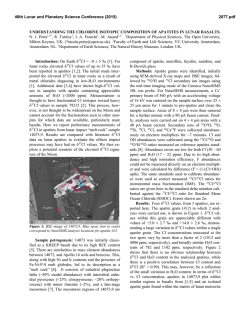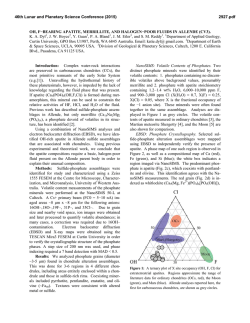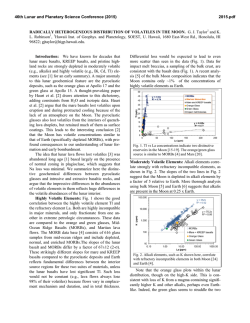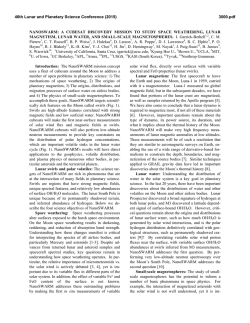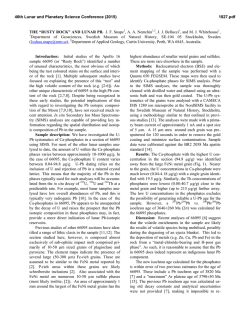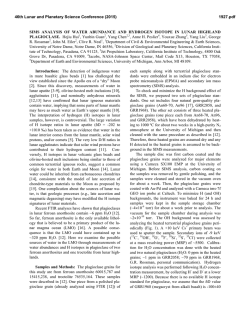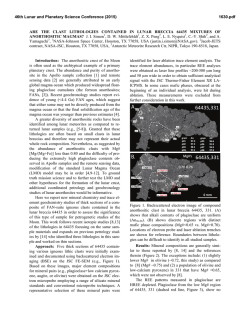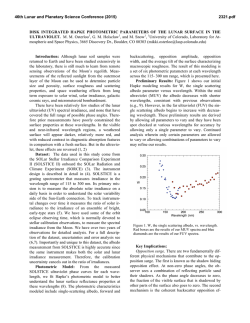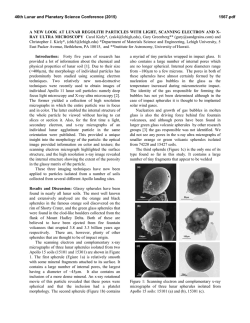
VOLATILES IN THE LUNAR CRUST – AN EVALUATION OF THE
46th Lunar and Planetary Science Conference (2015) 1352.pdf VOLATILES IN THE LUNAR CRUST – AN EVALUATION OF THE ROLE OF METASOMATISM. J. J. Barnes1, R. Tartèse1, M. Anand1,2, F. M. McCubbin3, I. A. Franchi1, N. A. Starkey1 and S. S. Russell1,2, 1Planetary and Space Sciences, The Open University, Milton Keynes, MK7 6AA, UK ([email protected]), 2 Department of Earth Sciences, Natural History Museum, Cromwell Road, London, SW7 5BD, UK. 3Institute of Meteoritics, University of New Mexico, 200 Yale Blvd SE, Albuquerque, NM 87131, USA. Introduction: Since the long standing paradigm of a anhydrous Moon was challenged [1] there has been a renewed focus on investigating volatiles in a variety of lunar samples [e.g., 1-8]. In particular, numerous studies have examined the abundances and isotopic compositions of volatiles in lunar apatites [2-3,5-8]. In fact, apatite has been used as a tool for assessing the sources of water in the lunar interior [e.g., 3,5-6]. Furthermore, studies of lunar apatite may help in elucidating secondary processes, involving volatiles, which may have operated in the lunar crust [e.g., 7-8]. We report apatite data from two Apollo 17 samples which likely record post-crystallization metasomatic alteration that the host rocks experienced while residing in the lunar crust. Samples: Apollo 17 samples 76535 (troctolite) and 79215 (granulite) were analyzed in this study. 76535 has a crystallization age of ca. 4.37 Ga [e.g., 9], and a weighted average cosmic-ray exposure (CRE) age of 211 ± 23 Ma (summarized in [6]). 79215 is ca. 3.9 Ga old [e.g., 10] and has an average CRE age of ~ 255 ± 24 Ma [10-11]. Three apatite grains in the polished thin-section 76535,51 were analyzed. They range in shape from euhedral to subhedral and in size from ~ 50 μm to 250 μm in the longest dimension. Each of the apatites were associated with merrillite, and one grain was also found associated with a clinopyroxene rim and a symplectite assemblage (Fig. 1a). Such features are similar to those reported by [8]. Both apatite and merrillite are in contact with early-formed clinopyroxene, and apatite is also in contact with symplectite assemblages, and, as such, it is difficult from textural observations alone to determine the relative timing of the formation of the two phosphates. In 79215,50 apatite is abundant, occurring with olivine, plagioclase, and troilite. The apatites are mostly subhedral and range in size from ~ 30 μm to > 400 μm in the longest dimension (Fig. 1b). Most of the apatites contain rounded blebs of plagioclase and olivine, with lobate crystal edges. The apatites appear to cross-cut the main rock-forming minerals, suggesting it is a late/post-granulite-formation phase (Fig. 1b). No merrillite was found in the studied thin-section. Apatite is found in the interior of the troctolitic clast/olivine-rich portion of the breccia or at the boundary between the clast and the matrix. Apatite does not appear to be confined to curvilinear trails, nor does apatite occur in the feldspathic-rich matrix, as observed by [7]. Figure 1. Backscatter electron images of apatite (Ap) in a) troctolite 76535 and b) granulite 79215. Where: Cpx = clinopyroxene, Ol = olivine, Merr = merrillite, Plag = plagioclase, Sp = spinel, and Sym = symplectite. Methods: Measurement of the H2O content and Hisotopic composition of apatites in polished thinsections of 76535 and 79215 were performed using the Cameca NanoSIMS 50L ion probe at The Open University, following protocols described in [5-6]. In addition, chlorine isotope measurements of apatite in 79215 were made using the NanoSIMS following the protocol of [12]. Abundance measurements of F, Cl, and H2O in apatite in 76535 were also made using electron microprobe analysis (EMPA) [6]; whereas abundance measurements of volatiles in apatite in 79215 were made along with the Cl-isotope measurements, using the NanoSIMS set-up for the collection of F, Cl, and SO2. Results and Discussion: It should be noted that the measurements of D/H ratios in these samples are particularly challenging because of the very low H2O contents of the apatites. δD-H2O data were corrected for the effects of spallation reactions after [6]. Apatite in 76535 has a δD value (n = 1) of +725 ± 437 ‰ (2σ) and H2O content of 28 ± 1 ppm (Fig. 2; [6]). The five apatites analyzed (n = 8) in 79215 have δD values from -565 ± 492 to +1859 ± 479 ‰ and H2O contents from 24 ± 0.4 to 91 ± 1 ppm (Fig. 2). The apatites in 76535 have ~ 3.24 ± 0.30 wt.% F and 1.08 ± 0.16 wt.% Cl as determined by EMPA [6]. Five analyses of a single apatite grain in 79215 give a weighted average δ37Cl value of +27.7 ± 1.4 ‰ and Cl content of ~ 0.70 ± 0.02 wt.%. This apatite also has an average of 2.98 ± 0.15 wt.% F and 91 ± 5 ppm SO2. Volatiles in apatite. Apatites in 76535 have similar volatile compositions as those reported by [8], with consistent results within and between grains. The single δD-H2O measurement is comparable to that reported by [13-14], with the δD signature being relatively elevated when compared to apatites in other highlands 46th Lunar and Planetary Science Conference (2015) samples [6]. Likewise, analyses of volatiles in apatites in 79215 are comparable to the analyses reported by [7] and apatite is confirmed to be dry. The total variation in δD signatures in this sample encompasses the range of apatite δD values from cumulate norites [6] to high-Ti mare basalts [e.g., 3]. Most of the δD-H2O results are within error of each other, however there is an indication that degassing may have been involved (Fig. 2). The δ37Cl values are homogeneous from core to rim of the single apatite grain analyzed in 79215. Moreover, the results are consistent with those previously reported by [7], and the results from other lunar highlands apatites [13]. Agents of alteration. Troctolite 76535 is an unshocked cumulate sample, which is thought to have formed in a shallow level (crustal) magma chamber, undergoing fractional crystallization. This, together with the observation of symplectite assemblages in the vicinity of apatite-merrillite pairs (Fig. 1a; [8]), has been used as evidence to favor the idea that magmatic apatite was altered by post-magmatic metasomatism, probably involving a halogen-poor melt [8]. In this work, we find no conclusive textural evidence to support/refute this hypothesis or the possibility that apatite was formed later by the alteration of magmatic merrillite (also explored by [8]) after the infiltration of a halogen-rich melt, similar to the scenario considered for GRA 06128 meteorite [15]. The relatively elevated δD value of the apatite compared to the other highland apatites from similar rock types [6] may suggest that some degassing of H2 or diffusion of OH occurred, however, it is not possible to confirm this without additional, higher resolution δD-H2O data from multiple apatite grains in this sample. If degassing did occur it might help support a scenario in which apatite was a non-magmatic phase which formed later in the shallow lunar crust. In contrast, the granulite 79215 is thought to represent a polymict breccia that originally consisted of olivine-rich and feldspathic clasts, which was thermally metamorphosed and recrystallized at low pressures and at high temperatures of ~ 1000 °C, probably triggered by an impact event. It has previously been suggested that 79215 was altered by a fluid/vapor that carried the apatite-forming ingredients from a ‘KREEP-rich’ source to the site of the granulite. Regardless of whether the agent was a fluid/vapor, the fact that apatite is observed in both the troctolitic portion of the granulitic breccia [this work] and in the matrix [7], suggests that the alteration agent was enriched in P and halogens (F and Cl), and was pervasive throughout the entire ‘granulite-regolith’ rock unit. Currently, there is insufficient understanding of the process(es) influencing the Cl-isotopic composition of lunar apatites but it is intriguing that some highlands 1352.pdf apatites, which are found in rocks that have not experienced metasomatic alteration, also display elevated δ37Cl signatures [13] relative to terrestrial values. Additionally, apatites in KREEP basalt clasts in both Apollo samples and lunar meteorites [12,16], and a lunar gabbroic meteorite NWA 2977 [17] have similarly elevated δ37Cl values, comparable to apatites in 76535 and 79215. This suggests that the elevated δ37Cl values are unlikely to be an indicator of metasomatic alteration in such cases. Furthermore, these results do not support the role of impact processing [17] in giving rise to elevated Cl isotopic compositions, since the troctolite is an unshocked sample and yet its apatites have similar δ37Cl signatures to apatites from highlyshocked lunar meteorites [e.g., 12,17]. There is no obvious correlation between δ37Cl values and δD values of lunar apatites [12-13], and additional work is required to understand the processes operating in the Moon and perhaps at the surface during impact events, which may significantly fractionate Cl-isotopes under different petrological environments. Figure 2. Plot of δD values against H2O content for apatites analyzed in 76535 and 79215. Uncertainties are reported at the 2σ level. Acknowledgements: CAPTEM is thanked for allocation of Apollo samples. STFC is thanked for a PhD studentship to JJB, a research grant to MA (ST/I001298/1), and NanoSIMS access was through UKCAN (ST/1001964/1). References: [1] Saal A. E. et al. (2008) Science, 454, 192-195. [2] McCubbin F. M. et al. (2010) PNAS, 27, 1122311228. [3] Greenwood J. P. et al. (2011) Nat. Geosci., 4, 79-82. [4] Saal A. E. et al. (2013) Science, 340, 1317-1320. [5] Tartèse R. et al. (2013) GCA, 122, 58-74. [6] Barnes J. J. et al. (2014) EPSL, 390, 244-252. [7] Treiman A. H. (2014) Am. Min., 99, 1860-1870. [8] Elardo S. M. et al. (2012) GCA, 75, 3024-3045. [9] Borg L. et al. (2013) LPSC XLIV, Abstract #1563. [10] Hudgins J. A. et al. (2008) GCA, 140, 231-333. [11] McGee J. J. et al. (1978) LPSC IX, 743-772. [12] Tartèse R. et al. (2014) MAPS, 49, 2266–2289. [13] Boyce J. W. et al. (2013) LPSC XLIV, Abstract #2851. [14] Robinson K. L. et al. (2014) LPSC XLV, Abstract #1607. [15] Shearer C. K. et al. (2011) MAPS, 46, 1345-1362. [16] Sharp Z. D. (2010) Science, 329, 10501053. [17] Wang Y. et al. (2012) METSOC LXXV, Abstract #5170.
© Copyright 2025
